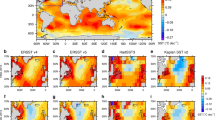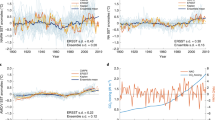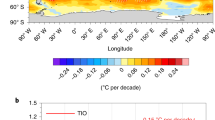Abstract
Evidence from palaeoclimatology suggests that abrupt Northern Hemisphere cold events are linked to weakening of the Atlantic Meridional Overturning Circulation (AMOC)1, potentially by excess inputs of fresh water2. But these insights—often derived from model runs under preindustrial conditions—may not apply to the modern era with our rapid emissions of greenhouse gases. If they do, then a weakened AMOC, as in 1975–1998, should have led to Northern Hemisphere cooling. Here we show that, instead, the AMOC minimum was a period of rapid surface warming. More generally, in the presence of greenhouse-gas heating, the AMOC’s dominant role changed from transporting surface heat northwards, warming Europe and North America, to storing heat in the deeper Atlantic, buffering surface warming for the planet as a whole. During an accelerating phase from the mid-1990s to the early 2000s, the AMOC stored about half of excess heat globally, contributing to the global-warming slowdown. By contrast, since mooring observations began3,4,5 in 2004, the AMOC and oceanic heat uptake have weakened. Our results, based on several independent indices, show that AMOC changes since the 1940s are best explained by multidecadal variability6, rather than an anthropogenically forced trend. Leading indicators in the subpolar North Atlantic today suggest that the current AMOC decline is ending. We expect a prolonged AMOC minimum, probably lasting about two decades. If prior patterns hold, the resulting low levels of oceanic heat uptake will manifest as a period of rapid global surface warming.
This is a preview of subscription content, access via your institution
Access options
Access Nature and 54 other Nature Portfolio journals
Get Nature+, our best-value online-access subscription
$29.99 / 30 days
cancel any time
Subscribe to this journal
Receive 51 print issues and online access
$199.00 per year
only $3.90 per issue
Buy this article
- Purchase on Springer Link
- Instant access to full article PDF
Prices may be subject to local taxes which are calculated during checkout




Similar content being viewed by others
References
McManus, J. F., Francois, R., Gherardi, J.-M., Keigwin, L. D. & Brown-Leger, S. Collapse and rapid resumption of Atlantic meridional circulation linked to deglacial climate changes. Nature 428, 834–837 (2004).
Manabe, S. & Stouffer, R. J. Coupled ocean-atmosphere model response to freshwater input: comparison to Younger Dryas Event. Paleoceanography 12, 321–336 (1997).
McCarthy, G. D. et al. Measuring the Atlantic Meridional Overturning Circulation at 26° N. Prog. Oceanogr. 130, 91–111 (2015).
Smeed, D. A. et al. Observed decline of the Atlantic meridional overturning circulation 2004-2012. Ocean Sci. 10, 29–38 (2014).
Srokosz, M. A. & Bryden, H. L. Observing the Atlantic Meridional Overturning Circulation yields a decade of inevitable surprises. Science 348, (2015).
Zhang, R. Coherent surface-subsurface fingerprint of the Atlantic meridional overturning circulation. Geophys. Res. Lett. 35, L20705 (2008).
Loeb, N. G. et al. Observed changes in top-of-the-atmosphere radiation and upper-ocean heating consistent within uncertainty. Nat. Geosci. 5, 110–113 (2012).
Solomon, S. et al. (eds) Climate Change 2007: the Physical Science Basis. Contribution of Working Group I to the Fourth Assessment Report of the Intergovernmental Panel on Climate Change (Cambridge Univ. Press, Cambridge, 2007).
Lee, S.-K. et al. Pacific origin of the abrupt increase in Indian Ocean heat content during the warming hiatus. Nat. Geosci. 8, 445–449 (2015).
Nieves, V., Willis, J. K. & Patzert, W. C. Recent hiatus caused by decadal shift in Indo-Pacific heating. Science 349, 532–535 (2015).
Chen, X. & Tung, K. K. Varying planetary heat sink led to global-warming slowdown and acceleration. Science 345, 897–903 (2014).
Thompson, D. W. J. & Solomon, S. Interpretation of recent Southern Hemisphere climate change. Science 296, 895–899 (2002).
Thornalley, D. J. R. et al. Anomalously weak Labrador Sea convection and Atlantic overturning during the past 150 years. Nature 556, 227–230 (2018).
Lozier, M. S. Overturning in the North Atlantic. Annu. Rev. Mar. Sci. 4, 291–315 (2012).
Robson, J., Ortega, P. & Sutton, R. A reversal of climatic trends in the North Atlantic since 2005. Nat. Geosci. 9, 513–517 (2016).
Jackson, L. C., Peterson, K. A., Roberts, C. D. & Wood, R. A. Recent slowing of Atlantic overturning circulation as a recovery from earlier strengthening. Nat. Geosci. 9, 518–522 (2016).
Beckley, B. D. et al. Assessment of the Jason-2 extension to the TOPEX/Pseidon, Jason-1 sea-surface height time series for global mean sea level monitoring. Mar. Geodesy 33, 447–471 (2010).
Willis, J. K. Can in situ floats and satellite altimeters detect long-term change in Atlantic Ocean overturning? Geophys. Res. Lett. 37, https://doi.org/10.1029/2010GL042372 (2010).
Yan, X., Zhang, R. & Knutson, T. R. The role of Atlantic overturning circulation in the decent decline of Atlantic major hurricane frequncy. Nat. Commun. 8, (2017).
Zhang, R. On the persistence and coherence of subpolar sea surface temperature and salinity anomalies associated with the Atlantic multidecadal variability. Geophys. Res. Lett. 44, 7865–7875 (2017).
Caesar, L., Rahmstorf, S., Robinson, A., Feulner, G. & Saba, V. Observed fingerprint of a weakening Atlantic Ocean overturning circulation. Nature 556, 191–196 (2018).
McCarthy, G. D. & Haigh, I. D., Hirschi, J. J.-M., Grist, J. P. & Smeed, D. A. Ocean impact on decadal Atlantic climate variability revealed by sea-level observations. Nature 521, 508–510 (2015).
Polyakov, I. V. et al. Arctic Ocean freshwater changes over the past 100 years and their causes. J. Clim. 21, 364–384 (2008).
Chen, X. & Tung, K. K. Global mean surface temperature variability—space-time perspective from rotated EOFs. Clim. Dyn. https://doi.org/10.1007/s00382-017-3979-0 (2017).
Wu, Z., Huang, N. E., Wallace, J. M., Smoliak, B. & Chen, X. On the time-varying trend in global-mean surface temperature. Clim. Dyn. 37, 759–773 (2011).
Zhang, R., Delworth, T. L. & Held, I. M. Can the Atlantic Ocean drive the observed multidecadal variability in Northern Hemisphere mean temperature? Geophys. Res. Lett. 34, L02709 (2007).
Tung, K. K. & Zhou, J. Using data to attribute episodes of warming and cooling in instrumental records. Proc. Natl Acad. Sci. USA 110, 2058–2063 (2013).
Cheng, L. J. & Zhu, J. Artifacts in variations of ocean heat content induced by the observation system changes. Geophys. Res. Lett. 41, 7276–7283 (2014).
Marshall, J. & Speer, K. Closure of the meridional overturning circulation through Southern Ocean upwelling. Nat. Geosci. 5, 171–180 (2012).
Yan, X., Zhang, R. & Knutson, T. R. The role of Atlantic Overturning Circulation in the recent decline of Atlantic major hurricane frequency. Nat. Commun. 8, 1695 (2017).
Danabasoglu, G. et al. North Atlatnic simulations in cordinated ocean-ice reference experiments phase II (CORE-II). Part II: interannual to decadal variability. Ocean Model. 97, 65–90 (2016).
Saba, V. S. et al. Enhanced warming of the Northwest Atlantic Ocean under climate change. J. Geophys. Res. Oceans 121, 118–132 (2016).
Zhang, R. & Vallis, G. K. The role of bottom vortex stretching on the path of the North Atlantic Western Boundary Current and on the North Recirculation Gyre. J. Phys. Oceanogr. 37, 2053–2080 (2007).
Enfield, D. B., Mestas-Nunez, A. M. & Trimble, P. J. The Atlantic multidecadal oscillation and its relation to rainfall and river flows in the continental U. S. Geophys. Res. Lett. 28, 2077–2080 (2001).
Delworth, T. L. & Mann, M. E. Observed and simulated multidecadal variability in the Northern Hemisphere. Clim. Dyn. 16, 661–676 (2000).
Zhou, J., Tung, K. K. & Li, K.-F. Multidecadal variability in the Greenland ice-core records obtained using Intrinsic Time-scale Decomposition. Clim. Dyn. 47, 739–752 (2016).
Lorbacher, K., Marsland, S. J., Church, J. A., Griffies, S. M. & Stammer, D. Rapid barotropic sea level rise from ice sheet melting. J. Geophys. Res. 117, (2012).
Acknowledgements
The research of K.-K.T. is supported by the National Science Foundation, under AGS-1262231 and by the Frederic and Julia Wan Endowed Professorship. X.C. was supported by the National Key Basic Research Program of China under grant 2015CB953900 and by the Natural Science Foundation of China under grants 41330960 and 41776032.
Author information
Authors and Affiliations
Contributions
K.-K.T. and X.C. undertook the analysis of global ocean temperature and salinity profiles, RAPID observations, and satellite altimetry datasets. K.-K.T. led the draft of this manuscript. X.C. produced all figures. Both authors contributed substantially to the drafting and revision of this manuscript.
Corresponding author
Ethics declarations
Competing interests
The authors declare no competing interests.
Additional information
Publisher’s note: Springer Nature remains neutral with regard to jurisdictional claims in published maps and institutional affiliations.
Extended data figures and tables
Extended Data Fig. 1 Unfiltered AMOC proxy time series in monthly resolution.
The thick solid lines are 13-month running means. The numbers to the right of each time series show the correlation coefficient with the unfiltered AMOC subsurface temperature fingerprint of Zhang. Data are taken from refs 20,21,22. All of the correlation coefficients are above 95% confidence level. The accumulated sea-level index is shifted to the right by 4.8 years in this figure. Without the time shift, its correlation with the AMOC proxy is practically zero (r = 0.06).
Extended Data Fig. 2 Error bars for the three salinity time series shown in Fig. 1.
The colour lines are monthly values of uncertainty, superimposed on the 13-month means of the time series. psu, practical salinity units.
Extended Data Fig. 3 Coincidence of the three AMOC phases with global warming slowdown and acceleration.
a, Global mean surface temperature. b, OHC north of 45° N in the Atlantic. c, Salinity north of 45° N in the Atlantic.
Extended Data Fig. 4 Deep Labrador Sea density:
Average density in the 1,000–1,500 m layer of the Labrador Sea, regionally averaged over the ocean area shown in the inset, from the three data sources given. A leading signal for stronger AMOC is the increased deep Labrador Sea salinity (and hence density). The signal propagates southward along the western boundary at depth, changing the cross-basin zonal gradient, and hence the geostrophic southward velocity13. The return flow then strengthens the upper branch of AMOC with a lag of 7–10 years15,16.
Extended Data Fig. 5 SST patterns during different AMOC phases.
a, When AMOC is below climatology. b, When AMOC is above climatology, SST detrended. c, SST linear trend when AMOC is increasing. d, When AMOC is decreasing.
Extended Data Fig. 6 Linear trends, from 1950 to 2017, of temperature, salinity and density.
a–c, Trends in temperature (a), salinity (b) and density (c) as a function of depth. Solid curves indicate where the trend is statistically significant at 95% confidence level.
Extended Data Fig. 7 Temperature–salinity diagram.
The subpolar Atlantic Ocean (45°–65° N) for each depth between 300 m and 1,500 m for the two periods, with the mean of 2000–2016 in red and the mean of 1920–1940 in blue. The dots shown are the five winter month values (NDJFM). At these depths the seasonal cycle is very small38.
Rights and permissions
About this article
Cite this article
Chen, X., Tung, KK. Global surface warming enhanced by weak Atlantic overturning circulation. Nature 559, 387–391 (2018). https://doi.org/10.1038/s41586-018-0320-y
Received:
Accepted:
Published:
Issue Date:
DOI: https://doi.org/10.1038/s41586-018-0320-y
This article is cited by
-
Reply to: Evidence lacking for a pending collapse of the Atlantic Meridional Overturning Circulation
Nature Climate Change (2024)
-
Increased Asian aerosols drive a slowdown of Atlantic Meridional Overturning Circulation
Nature Communications (2024)
-
Evidence lacking for a pending collapse of the Atlantic Meridional Overturning Circulation
Nature Climate Change (2024)
-
Rotating tank experiments for the study of geophysical fluid dynamics
Journal of Oceanology and Limnology (2024)
-
Solar cycle as a distinct line of evidence constraining Earth’s transient climate response
Nature Communications (2023)
Comments
By submitting a comment you agree to abide by our Terms and Community Guidelines. If you find something abusive or that does not comply with our terms or guidelines please flag it as inappropriate.



